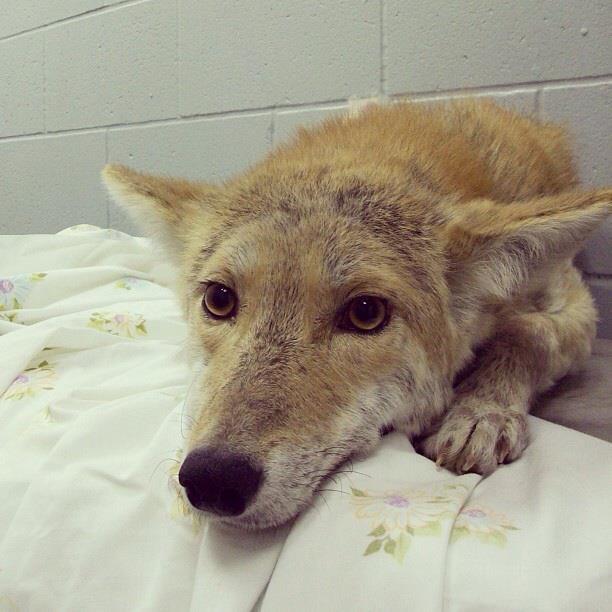Did Our Ignorance Kill a Toronto Coyote?
huffingtonpost.com

On Monday night in Toronto, a coyote was doing what coyotes often do this time of year. She was out roaming for food, which is scarcer in the winter months. That sometimes means traveling a little further from home. For this coyote, who lived in the park lands surrounding the Don Valley Parkway, a little further from home meant the edge of Cabbagetown, which was likely full of appetizing smells after the big thaw. The coyote's punishment for following her nose? She was chased, shot at, and killed by police, just half a block from Wellesley Park.
According to Toronto Police, who cited "public safety" as their primary concern, "the animal was acting aggressively." This claim was called into question for many when video footage of the incident was released showing a small, calm coyote looking every bit like a lost dog and nothing at all like a rabid, menacing killer. Nathalie Karvonen, Executive Director of Toronto Wildlife Centre,said after viewing the footage that "it was clear" the coyote was not aggressive.
Why then, were police so quick to kill the animal? One would think that coyotes must have an extremely violent track record to warrant such automatic brutality. But this couldn't be further from the truth.
A recent study reports that in North America, from 1960 to 2006, there were a total of 142 reported incidents of coyotes biting humans, or around 3 per year on the entire continent. Fatalities are much rarer still, with only a single recorded case in Canada's history. Likewise, the City of Toronto has only one coyote incident on record, from more than a decade ago, when a woman received a minor bite after regularly feeding a wounded coyote.
Meanwhile, there are approximately 460,000 dog bites each year in Canada alone, 1-2 of which prove fatal. The average Canadian is several hundred thousand times more likely to be bitten by a leashed labrador than by a wild, roaming coyote.
For anyone familiar with coyotes, the lack of incidents comes as no surprise, since coyotes are extremely shy and non-confrontational. They are also known for being especially playful canids who sleep deeply, are devoted parents and practice monogamy. In fact, alpha males have beenknown to leave their packs and lead solitary lives after the death of their mate. Andrew Wight, a Rescue and Release Coordinator at the Toronto Wildlife Centre for over a decade, has worked with hundreds of coyotes, and has this to say of them:
"Of the more than 270 species of wildlife we rescue and rehabilitate, coyotes are one of the easiest mammals to handle, as they are extremely passive with humans and never show unprovoked aggression. They're also much smaller than most people realize, usually between 30-39 pounds. They're basically just small dogs who are afraid of people."
So why the bad rap?
Media misrepresentation is largely to blame. Fear-based reporting sells more newspapers and keeps more people glued to televisions than fact-based assessments. Dr. Shelley Alexander from the University of Calgary conducted an analysis of media pieces on coyotes and found several concerning trends. For example, while 185 articles describe human-coyote interactions as "attacks," only 32 "attacks" were identified. The most common terms used to describe coyotes were: brazen, wiley, mangy, nuisance, wild, and vicious.
This sort of misrepresentation doesn't just sell papers, it also sells coats. The fur industry (including Canada Goose) routinely depicts coyotes as pests that attack other animals, and people,to assuage the public's natural aversion to wearing their fur. Across Canada, 50,000 to 100,000 coyotes are killed each year, many of them reduced to the superficial fur trim on Canada Goose,CMFR, Outdoor Survival Canada, Nobis, and Mackage coats.
Coyotes are in Toronto, and they're here to stay. As rural spaces become increasingly urbanized, the loss of habitat makes it geographically impossible for human-coyote interactions to be completely avoided. The good news is that the frequency and intensity of these interactions is largely under our control, since the vast majority occur as a result of "human provided" sources of food, including unsecured garbage, compost, and dog and cat food left outside. Communities across the country (including Vancouver, Edmonton, Oakville, and Niagara Falls) are proving that if citizens are informed and potential food sources eliminated, human-coyote interactions plummet.
Coyotes in urban environments are a human-made problem, making it our responsibility to find peaceful solutions. The situation on Monday night should lead each and every one of us -- whether we live in Toronto, Tofino or Tobermory -- to ask ourselves what kind of communities we want to live in. Communities that respect wild animals, or treat them with fear and disdain? Communities that live peacefully with wild animals, or violently eradicate them? For most people, I think the choice is very clear. Despite our encroaching upon their habitats -- their homes -- the coyotes continue to show us respect. It is time we did the same.
Note: In light of Monday's incident, the Association for the Protection of Fur-Bearing Animals,Coyote Watch Canada and Toronto Wildlife Centre are calling on Toronto City Council to enact a by-law regulating the feeding of wildlife, and to implement a coyote education program. You can get more information about supporting this initiative here.










No comments:
Post a Comment